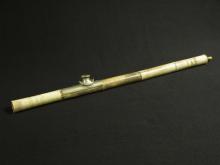Opium and the Opening of China
The Portuguese introduced opiumOpium
By the 18th century, smoking opium had become a common addiction in China. Approximately 10 million people, out of a population of 400 million, were addicted. Although initially a fad of the rich upper class in China, opium use spread to government officials, merchants, soldiers, students, servants, and even priests, monks, and nuns.
Read more to China against the wishes of the Chinese emperor. Later, England brought opium grown in India into Canton, and after 1838 the British allowed the United States to participate in the opium trade. Opium was used by British and American citizens too, and was not considered an illegal or dangerous drug at the time. In 1840-42, the Chinese fought the British in an attempt to ban opium, but were defeated. As a result of the Opium WarsOpium Wars
In 1838 the Chinese Emperor ordered a complete halt to opium traffic in Canton. He appointed a special commissioner to make sure the trade was stopped; this commissioner confiscated huge stores of the drug and dumped them into the sea. He then suspended trade with the British. England reacted with anger.
Read more England acquired Hong Kong, and four more ports opened to foreign trade: Shanghai, Ningpo, Foochow, and Amoy.
The opium wars of 1840-1842 divided the China Trade into two periods:
1. The Old China TradeOld China Trade
When foreign ships arrived in Whampoa, during the days of the "Old China Trade," they carried a Chinese pilot, who boarded at Macao. The ship was then required to report to the local authorities: the Hoppo, or chief Chinese customs inspector.Read more. before the Treaty of NankingTreaty of Nanking
The treaty ending the Opium Wars between China and Great Britain in 1842, resulting in China being forced to open more ports to western trade. in 1842 and the Treaty of WhanghiaTreaty of Whanghia
The treaty between the United States and China, granting the same rights to the U.S. as Britain received under the Treaty of Nanking. in 1843. During this period Canton was the only port open to foreign traders.
2. Trade in the period after 1844, when more Chinese ports were open to the west. The United States was more active in the later years of the China Trade, especially after the Civil War. The opening of Japan in 1853 was a critical event for European and American trade with the Asian Pacific. Maine’s role in trade with Asia reached its peak in the latter part of the 19th century.

